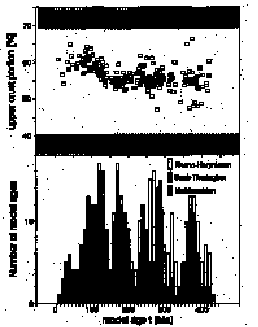
Isotopic investigations of common lead as well as literature data from Germany and East France (222 PbS-analyses (Lippolt et al., 1983; Wedepohl et al., 1978; Krahn, 1988; Marcoux, 1986; Werner and Lippolt, 1996) lead us to develop a regional evolution model. The data comprize Variscan and Mesozoic mineralisations in the basement (Moldanubian, Saxo-Thuringian, Rheno-Hercynian) and syn- and epi-genentic mineralisations in supracrustal formations. U-, Th- and Pb-mobilities are highly sensitive to the conditions of lead evolving reservoirs. A mean global fractionation trend for different terrestrial reservoirs concerning these elements has been evidenced experimentally (Zartman and Haines, 1988). The whole data pattern was recognized to represent orogenetic lead formed by recycling processes of older orogenic components with contributions received from the mantle and the preexisting continental crust, subcrustal lithosphere. The mixing formula introduced here allows calculation of reservoir portions pi (signatures) with respect of three given reservoirs (upper crust, lower crust, mantle - model fitting parameters) and of a model age t resulting from the evolution of the reservoirs.

where
![]()
![]()
Parameters: mi, ei, ci: isotopic composition of reservoir; li: decay constants; pi: relative contribution; t: model age; end: final composition; i: reservoir.
The model age: The model fit minimizes the variation of the model ages. Data fitting also leads to specific clusters in the p-t diagram (Fig. 1a) which are not recognizable in the conventional a-b- and a-g-diagrams. The significance of this approach concerning the model age was positively tested by regarding syn-genetic continental mineralisations. For ores from marine sediments as well as for recent oceanic lead the model ages are generally too high. Admixture of oceanic lead is plausible. In the histogram (Fig. 1b) the positions of frequency maxima are similar to those from other investigations such as dating of hydrothermal feldspar, illite and sericite. However, the significance of this coincidence has not yet been proved.
The mixing parameters: With respect to the temporal evolution of mixing signatures (Fig. 1a) and correlations between the mixing parameters the following model is discussed: Only mantle and lower crust signatures are strongly negative correlated (here
not shown), therefore different main mixing processes (1,2) are neccessary, based on basement lead measurements (Kober and Lippolt, 1985); (1) Pre-Variscan or Variscan mantle lead injection - incomplete admixing to slightly fractionated Pre-Variscan basement rocks; (2) mobilization of radiogenic lead components by the Variscan orogeny or by Variscan and Mesozoic hydrothermal leaching; (3) Mesozoic periodical mobilisation of U, Th and Pb leads to homogenization and fractionation (upper crust signature
is increasing). Correlations of common lead isotope composition with tectonical events appear to be probable; however, further independent investigations are needed. Thus, lead isotopes are suitable as tracers but can not substitute absolute dating methods.
Kober, B. & Lippolt, H.J., Contrib. Min. Petrol. 90, 162-178 (1985).
Krahn, L., Diss. TH Aachen (1988).
Lippolt, H.J., et al. Geol. Rundsch. 72, 1-17 (1983).
Marcoux, E., Thèse doct. Clermont-Ferrand (1986).
Werner, O. & Lippolt, H.J., in preparation (1996).
Wedepohl, K.H., et al., Contr. Min. Petrol. 65, 273-281 (1978).
Zartman, R.E. &, S.M., Geochim. Cosmochim. Acta 52, 1327-1339 (1988).
Fig. 1: A (below): model date histogram; B (above): exemplary temporal evolution of upper crust portions (signature) calculated by data-fitted mixing simulation.